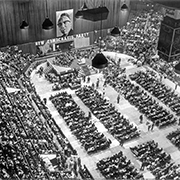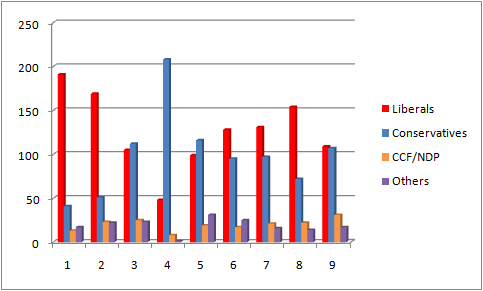CANADA HISTORY
NDP

As the Second World War drew to a close, Canadian politics entered a transformative period, shaped by the social and economic upheavals of the war and the global rethinking of government’s role in providing social services. The Liberal government under Mackenzie King recognized the shifting tides and began to adopt many progressive policies originally championed by the Co-operative Commonwealth Federation (CCF), a socialist party founded in 1932 during the depths of the Great Depression. The CCF had long advocated for policies such as old age security, unemployment insurance, and Medicare—all programs aimed at addressing the inequities in Canadian society.
The adoption of these policies by King’s government was not just a response to the public’s growing appetite for social security but also a strategic political move. King, who had a reputation as a cautious reformer, was keen to neutralize the growing appeal of the CCF. By co-opting key elements of the CCF’s platform, the Liberals sought to present themselves as a party that could deliver meaningful reform without embracing the socialist label. This political maneuvering helped the Liberals maintain power while marginalizing the CCF, which found itself struggling to differentiate its platform from that of the ruling party.
The Rise of the CCF and Its Early Promise
The Co-operative Commonwealth Federation was founded during the worst economic crisis in Canadian history, with a platform that offered hope to millions of Canadians devastated by unemployment, poverty, and economic insecurity. The CCF was built on a foundation of socialist principles, inspired by thinkers such as J.S. Woodsworth and Tommy Douglas, who believed in creating a more equitable society through government intervention and public ownership of key industries. Its early promise lay in the way it spoke directly to the needs of working-class Canadians, farmers, and those left behind by capitalism’s boom-and-bust cycles.
The party gained popularity in the 1940s, buoyed by its success in Saskatchewan, where Tommy Douglas became premier in 1944. Douglas's administration became the first social democratic government in North America, implementing progressive reforms that included public hospital insurance—the precursor to Canada’s universal health care system. The success of the CCF in Saskatchewan demonstrated that socialist policies could be not only popular but also effective in improving the lives of citizens. Nationally, however, the CCF struggled to break through. Although it had some success in Western Canada, it faced deep skepticism in other parts of the country, particularly in Quebec, where conservative Catholic values and wariness of socialism made the CCF a hard sell.
Liberal Co-option and the Marginalization of the CCF
Mackenzie King’s Liberal government, observing the popularity of the CCF’s social policies, moved to adopt many of these proposals as its own, especially in the immediate post-war period. Programs like old age security and unemployment insurance were introduced, while discussions about universal health care gained traction. By taking on these popular CCF initiatives, the Liberals effectively positioned themselves as the party of progressive reform without adopting the more radical rhetoric associated with the CCF.
This strategy severely undermined the CCF’s national standing. The CCF, already facing challenges due to accusations of being too radical or even communist, found itself struggling to offer a distinctive alternative to the Liberals. During the early stages of the Cold War, the CCF was frequently labeled as sympathetic to the Soviet Union, an accusation that, while largely unfounded, carried weight in an era of anti-communist sentiment. Conservative groups and right-wing commentators capitalized on these fears, painting the CCF as a dangerous party whose socialist agenda could lead to communist infiltration.
By the late 1950s, the CCF's national fortunes were declining. Its socialist platform, once seen as visionary, now appeared redundant in the face of Liberal reforms. In the 1958 federal election, the CCF suffered a crushing defeat, winning only eight seats in the House of Commons. This loss was a turning point, as the electorate overwhelmingly turned to the Progressive Conservatives under John Diefenbaker, who won in a landslide. The CCF’s support had largely evaporated, as voters who desired change flocked to the more centrist Progressive Conservatives or remained with the Liberals.
The Winnipeg Declaration and the Shift to the Centre
In response to its declining fortunes, the CCF made a strategic pivot in 1956 with the passage of the Winnipeg Declaration. This declaration marked a shift toward a more centrist, pragmatic political approach. It signaled a departure from the party’s earlier focus on state ownership and heavy government intervention in the economy, instead emphasizing a willingness to work with business and appealing to middle-class voters. The party still held to its commitment to social justice and economic reform, but the Winnipeg Declaration was intended to make the CCF more electable by softening its socialist image.
However, the shift to the centre did little to halt the party’s decline. The Diefenbaker government’s populist appeal had siphoned off much of the CCF’s Western base, and the party struggled to gain ground in other regions, particularly Quebec, where long-standing suspicions of the CCF remained entrenched. Despite its attempts to reposition itself, the CCF could not recover its earlier momentum, and by the end of the 1950s, it was clear that a new approach was needed.
The Birth of the NDP and Tommy Douglas’s Leadership
Faced with the reality of its diminishing influence, the CCF sought to rebuild by forging stronger alliances with organized labor. Discussions began with the Canadian Labour Congress (CLC) about forming a new political party that could unite the CCF’s supporters with the broader labor movement. These talks culminated in the creation of the New Democratic Party (NDP) in 1961, a bold move intended to re-energize the progressive movement in Canada and build a broader coalition that could compete more effectively in federal elections.
The newly formed NDP needed a dynamic leader to rally supporters, and it found one in Tommy Douglas, who had by then earned a national reputation for his pioneering work in Saskatchewan. Douglas’s Medicare program, which provided universal healthcare in the province, was a monumental success and would later serve as the model for Canada’s national healthcare system. As a leader, Douglas was charismatic, articulate, and deeply committed to social justice. His leadership gave the NDP the credibility it needed to present itself as a viable national alternative to the Liberals and Progressive Conservatives.
Under Douglas, the NDP saw an immediate resurgence. In the 1962 federal election, the party more than doubled its representation in Parliament, winning 19 seats—a significant recovery from the dismal showing of the CCF just four years earlier. Over the next decade, the NDP continued to build on its successes, becoming a fixture in federal politics. By 1972, the NDP had grown to 31 seats, playing a pivotal role in supporting Pierre Trudeau's minority Liberal government. This position gave the NDP significant influence over public policy, and many of its social democratic ideas were integrated into the national discourse.
Conclusion: The Legacy of the CCF and NDP
The transformation of the Co-operative Commonwealth Federation into the New Democratic Party represents a critical chapter in the evolution of progressive politics in Canada. The CCF’s early advocacy for social programs such as old age security, unemployment insurance, and universal healthcare set the stage for many of the reforms that would define Canada’s social safety net. While the Liberal Party under Mackenzie King successfully co-opted many of these ideas in the post-war era, the CCF and later the NDP continued to push for deeper structural changes aimed at reducing inequality and expanding public services.
The formation of the NDP in 1961 marked a new era for progressive politics in Canada, with the party forging strong ties to organized labor and positioning itself as the primary voice of social democracy. Under Tommy Douglas’s leadership, the NDP brought the issue of Medicare to the national stage, playing a key role in the eventual establishment of universal healthcare across Canada. Although the NDP has never formed a federal government, its influence on Canadian politics is undeniable. Many of the policies it championed have been adopted by successive governments, cementing its legacy as a force for progressive change in Canada.
The CCF and NDP were instrumental in shaping Canada’s identity as a country that values social justice and equality. Their efforts helped to establish a robust welfare state that continues to provide essential services to millions of Canadians today. The evolution of these parties highlights the ongoing struggle to balance economic growth with the needs of the most vulnerable in society, a debate that remains central to Canadian politics.
Parties |
||||
| Election | Liberals | Conservatives | CCF/NDP | Others |
| 1949 | 191 | 41 | 13 | 17 |
| 1953 | 169 | 51 | 23 | 22 |
| 1957 | 105 | 112 | 25 | 23 |
| 1958 | 48 | 208 | 8 | 1 |
| 1962 | 99 | 116 | 19 | 31 |
| 1963 | 128 | 95 | 17 | 25 |
| 1965 | 131 | 97 | 21 | 16 |
| 1968 | 154 | 72 | 22 | 14 |
| 1972 | 109 | 107 | 31 | 17 |

Cite Article : www.canadahistory.com/sections/documents




